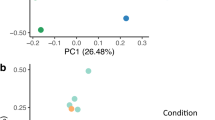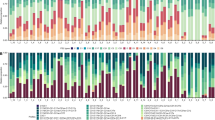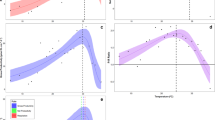Abstract
Understanding factors affecting the susceptibility of organisms to thermal stress is of enormous interest in light of our rapidly changing climate. When adaptation is limited, thermal acclimation and deacclimation abilities of organisms are critical for population persistence through a period of thermal stress. Holobionts (hosts plus associated symbionts) are key components of various ecosystems, such as coral reefs, yet the contributions of their two partners to holobiont thermal plasticity are poorly understood. Here, we tested thermal plasticity of the freshwater cnidarian Hydra viridissima (green hydra) using individual behavior and population responses. We found that algal presence initially reduced hydra thermal tolerance. Hydra with algae (symbiotic hydra) had comparable acclimation rates, deacclimation rates, and thermal tolerance after acclimation to those without algae (aposymbiotic hydra) but they had higher acclimation capacity. Acclimation of the host (hydra) and/or symbiont (algae) to elevated temperatures increased holobiont thermal tolerance and these effects persisted for multiple asexual generations. In addition, acclimated algae presence enhanced hydra fitness under prolonged sublethal thermal stress, especially when food was limited. Our study indicates while less intense but sublethal stress may favor symbiotic organisms by allowing them to acclimate, sudden large, potentially lethal fluctuations in climate stress likely favor aposymbiotic organisms. It also suggests that thermally stressed colonies of holobionts could disperse acclimated hosts and/or symbionts to other colonies, thereby reducing their vulnerability to climate change.
Similar content being viewed by others
Log in or create a free account to read this content
Gain free access to this article, as well as selected content from this journal and more on nature.com
or
References
Hoegh-Guldberg O. Climate change, coral bleaching and the future of the world’s coral reefs. Mar Freshw Res. 1999;50:839–66.
Saffo MB. Invertebrates in endosymbiotic associations. Integr Comp Biol. 1992;32:557–65.
Nowack ECM, Melkonian M. Endosymbiotic associations within protists. Philos Trans R Soc Lond B Biol Sci. 2010;365:699–712.
Wernegreen JJ. Endosymbiosis. Curr Biol. 2012;22:R555–R561.
Toby Kiers E, Palmer TM, Ives AR, Bruno JF, Bronstein JL. Mutualisms in a changing world: an evolutionary perspective. Ecol Lett. 2010;13:1459–74.
Correa AMS, Baker AC. Understanding diversity in coral-algal symbiosis: a cluster-based approach to interpreting fine-scale genetic variation in the genus Symbiodinium. Coral Reefs. 2009;28:81–93.
Baillie BK, Belda-Baillie CA, Silvestre V, Sison M, Gomez AV, Gomez ED, et al. Genetic variation in Symbiodinium isolates from giant clams based on random-amplified-polymorphic DNA (RAPD) patterns. Mar Biol. 2000;136:829–36.
Faeth SH. Asexual fungal symbionts alter reproductive allocation and herbivory over time in their native perennial grass hosts. Am Nat. 2009;173:554–65.
Guschina IA, Harwood JL. Mechanisms of temperature adaptation in poikilotherms. FEBS Lett. 2006;580:5477–83.
Zilber-Rosenberg I, Rosenberg E. Role of microorganisms in the evolution of animals and plants: the hologenome theory of evolution. FEMS Microbiol Rev. 2008;32:723–35.
Dunbar HE, Wilson ACC, Ferguson NR, Moran NA. Aphid thermal tolerance is governed by a point mutation in bacterial symbionts. PLoS Biol. 2007;5:e96.
Dimond JL, Holzman BJ, Bingham BL. Thicker host tissues moderate light stress in a cnidarian endosymbiont. J Exp Biol. 2012;215:2247–54.
Baird AH, Bhagooli R, Ralph PJ, Takahashi S. Coral bleaching: the role of the host. Trends Ecol Evol. 2009;24:16–20.
Berkelmans R, van Oppen MJ. The role of zooxanthellae in the thermal tolerance of corals: a ‘nugget of hope’ for coral reefs in an era of climate change. Proc R Soc B Biol Sci. 2006;273:2305–12.
Fitt WK, Gates RD, Hoegh-Guldberg O, Bythell JC, Jatkar A, Grottoli AG, et al. Response of two species of Indo-Pacific corals, Porites cylindrica and Stylophora pistillata, to short-term thermal stress: The host does matter in determining the tolerance of corals to bleaching. J Exp Mar Bio Ecol. 2009;373:102–10.
Ye S, Bhattacharjee M, Siemann E. Thermal tolerance in green hydra: identifying the roles of algal endosymbionts and hosts in a freshwater holobiont under stress. Microb Ecol. 2019;77:537–45.
Matthews JL, Sproles AE, Oakley CA, Grossman AR, Weis VM, Davy SK. Menthol-induced bleaching rapidly and effectively provides experimental aposymbiotic sea anemones (Aiptasia sp.) for symbiosis investigations. J Exp Biol. 2016;219:306–10.
Seebacher F, White CR, Franklin CE. Physiological plasticity increases resilience of ectothermic animals to climate change. Nat Clim Chang. 2015;5:61–66.
Castonguay E, Angers B. The key role of epigenetics in the persistence of asexual lineages. Genet Res Int. 2012;2012:1–9.
Verhoeven KJF, Preite V. Epigenetic variation in asexually reproducing organisms. Evolution. 2014;68:644–55.
Bay RA, Palumbi SR. Rapid acclimation ability mediated by transcriptome changes in reef-building corals. Genome Biol Evol. 2015;7:1602–12.
Richard J, Morley SA, Deloffre J, Peck LS. Thermal acclimation capacity for four Arctic marine benthic species. J Exp Mar Bio Ecol. 2012;424-5:38–43.
Ballinger RE, Schrank GD. Acclimation rate and variability of the critical thermal maximum in the lizard Phrynosoma cornutum. Phys Zool. 1970;43:19–22.
Calosi P, Bilton DT, Spicer JI. Thermal tolerance, acclimatory capacity and vulnerability to global climate change. Biol Lett. 2008;4:99–102.
Deutsch CA, Tewksbury JJ, Huey RB, Sheldon KS, Ghalambor CK, Haak DC, et al. Impacts of climate warming on terrestrial ectotherms across latitude. Proc Natl Acad Sci USA 2008;105:6668–72.
Sandblom E, Gräns A, Axelsson M, Seth H. Temperature acclimation rate of aerobic scope and feeding metabolism in fishes: implications in a thermally extreme future. Proc R Soc B Biol Sci. 2014;281:1490. https://doi.org/10.1098/rspb.2014.1490.
Bellantuono AJ, Hoegh-Guldberg O, Rodriguez-Lanetty M. Resistance to thermal stress in corals without changes in symbiont composition. Proceedings Biol Sci. 2012;279:1100–7.
Takahashi S, Yoshioka-Nishimura M, Nanba D, Badger MR. Thermal acclimation of the symbiotic alga Symbiodinium spp. alleviates photobleaching under heat stress. Plant Physiol. 2013;161:477–85.
Kenkel CD, Matz MV. Gene expression plasticity as a mechanism of coral adaptation to a variable environment. Nat Ecol Evol. 2016;1:0014.
Mayfield AB, Chan P-H, Putnam HM, Chen C-S, Fan T-Y. The effects of a variable temperature regime on the physiology of the reef-building coral Seriatopora hystrix: results from a laboratory-based reciprocal transplant. J Exp Biol. 2012;215:4183–95.
Heinemeyer A, Ineson P, Ostle N, Fitter AH. Respiration of the external mycelium in the arbuscular mycorrhizal symbiosis shows strong dependence on recent photosynthates and acclimation to temperature. New Phytol. 2006;171:159–70.
Brown BE. Coral bleaching: causes and consequences. Coral Reefs. 1997;16:S129–S138.
Fan Y, Wernegreen JJ. Can’t take the heat: high temperature depletes bacterial endosymbionts of ants. Microb Ecol. 2013;66:727–33.
Montllor CB, Maxmen A, Purcell AH. Facultative bacterial endosymbionts benefit pea aphids Acyrthosiphon pisum under heat stress. Ecol Entomol. 2002;27:189–95.
Wernegreen JJ. Mutualism meltdown in insects: bacteria constrain thermal adaptation. Curr Opin Microbiol. 2012;15:255–62.
Núñez-Pons L, Bertocci I, Baghdasarian G. Symbiont dynamics during thermal acclimation using cnidarian-dinoflagellate model holobionts. Mar Environ Res. 2017;130:303–14.
Mayfield AB, Fan TY, Chen CS. Physiological acclimation to elevated temperature in a reef-building coral from an upwelling environment. Coral Reefs. 2013;32:909–21.
Gibbin EM, Krueger T, Putnam HM, Barott KL, Bodin J, Gates RD, et al. Short-term thermal acclimation modifies the metabolic condition of the coral holobiont. Front Mar Sci. 2018;5:10.
Zuther E, Juszczak I, Ping Lee Y, Baier M, Hincha DK. Time-dependent deacclimation after cold acclimation in Arabidopsis thaliana accessions. Sci Rep. 2015;5:12199. https://doi.org/10.1038/srep12199.
Kalberer SR, Wisniewski M, Arora R. Deacclimation and reacclimation of cold-hardy plants: Current understanding and emerging concepts. Plant Sci. 2006;171:3–16.
Vega SE, Palta JP, Bamberg JB. Variability in the rate of cold acclimation and deacclimation among tuber-bearing Solanum (potato) species. J Am Soc Hortic Sci. 2000;125:205–11.
Jablonka E, Raz G. Transgenerational epigenetic inheritance: prevalence, mechanisms, and implications for the study of heredity and evolution. Q Rev Biol. 2009;84:131–76.
Heard E, Martienssen RA. Transgenerational epigenetic inheritance: myths and mechanisms. Cell. 2014;157:95–109.
Putnam HM. Resilience and acclimatization potential of reef corals under predicted climate change stressors. PhD Thesis 2012; University of Hawai’i at Manoa.
Verhoeven KJF, van Gurp TP. Transgenerational effects of stress exposure on offspring phenotypes in apomictic dandelion. PLoS ONE 2012;7:e38605.
Badhiwala KN, Gonzales DL, Vercosa DG, Avants BW, Robinson JT. Microfluidics for electrophysiology, imaging, and behavioral analysis of Hydra. Lab Chip. 2018;18:2523–39.
Murillo-Rincon AP, Klimovich A, Pemöller E, Taubenheim J, Mortzfeld B, Augustin R, et al. Spontaneous body contractions are modulated by the microbiome of Hydra. Sci Rep. 2017;7:15937.
Rahat M. Competition between Chlorellae in chimeric infections of Hydra viridis: the evolution of a stable symbiosis. J Cell Sci. 1985;77:87–92.
Fay SA, Weber MX, Lipps JH. The distribution of Symbiodinium diversity within individual host foraminifera. Coral Reefs. 2009;28:717–26.
Carlos AA, Baillie BK, Maruyama T. Diversity of dinoflagellate symbionts (zooxanthellae) in a host individual. Mar Ecol Prog Ser. 2000;195:93–100.
Mars Brisbin M, Mesrop LY, Grossmann MM, Mitarai S. Intra-host symbiont diversity and extended symbiont maintenance in photosymbiotic Acantharea (Clade F). Front Microbiol. 2018;9:1998.
Guyomar C, Legeai F, Jousselin E, Mougel C, Lemaitre C, Simon J-C. Multi-scale characterization of symbiont diversity in the pea aphid complex through metagenomic approaches. Microbiome. 2018;6:181.
Habetha M, Anton-Erxleben F, Neumann K, Bosch TCG. The Hydra viridis / Chlorella symbiosis. Growth and sexual differentiation in polyps without symbionts. Zoology. 2003;106:101–8.
Mews LK. The green hydra symbiosis. III. The biotrophic transport of carbohydrate from alga to animal. Proc R Soc B Biol Sci. 1980;209:377–401.
Cook CCB. Benefit to symbiotic zoochlorellae from feeding by green hydra. Biol Bull. 1972;142:236–42.
Pardy RL. Preparing aposymbiotic hydra. In: Lenhoff HM, editor. Hydra: Research Methods. US: Springer; 1983. p. 393–7.
Kessler E, Huss VAR, Rahat M. Species-specific ability of Chlorella strains (Chlorophyceae) to form stable symbioses with Hydra viridis. Plant Syst Evol. 1988;160:241–6.
Lenhoff HM, Brown RD. Mass culture of hydra: an improved method and its application to other aquatic invertebrates. Lab Anim. 1970;4:139–54.
Dunn K. Growth of endosymbiotic algae in the green hydra Hydra Viridissima. J Cell Sci. 1987;88:571–8.
Bossert P, Dunn KW. Regulation of intracellular algae by various strains of the symbiotic Hydra viridissima. J Cell Sci. 1986; 85:187–95.
Pardy RL, Muscatine L. Recognition of symbiotic algae by Hydra Viridis. A quantitative study of the uptake of living algae by aposymbiotic H. Viridis. Biol Bull. 1973;145:565–79.
Muggeo V. Segmented: An {R} package to fit regression models with broken-line relationships. R News. 2004;4:11–7.
Palumbi SR, Barshis DJ, Traylor-Knowles N, Bay RA. Mechanisms of reef coral resistance to future climate change. Science (80-). 2014;344:895–8.
Kikuchi Y, Tada A, Musolin DL, Hari N, Hosokawa T, Fujisaki K, et al. Collapse of insect gut symbiosis under simulated climate change. MBio 2016; 7.
Brucker RM, Bordenstein SR. The hologenomic basis of speciation: Gut bacteria cause hybrid lethality in the genus Nasonia. Science. 2013;341:667–9.
Kalisz S, Purugganan MD. Epialleles via DNA methylation: consequences for plant evolution. Trends Ecol Evol. 2004;19:309–14.
Tchernov D, Gorbunov MY, de Vargas C, Narayan Yadav S, Milligan AJ, Häggblom M, et al. Membrane lipids of symbiotic algae are diagnostic of sensitivity to thermal bleaching in corals. Proc Natl Acad Sci USA. 2004;101:13531–5.
Karmakar A, Karmakar S, Mukherjee S. Properties of various plants and animals feedstocks for biodiesel production. Bioresour Technol. 2010;101:7201–10.
Sachs JL, Russell JE, Lii YE, Black KC, Lopez G, Patil AS. Host control over infection and proliferation of a cheater symbiont. J Evol Biol. 2010;23:1919–27.
Wernegreen JJ, Wheeler DE. Remaining flexible in old alliances: functional plasticity in constrained mutualisms. DNA Cell Biol. 2009;28:371–82.
Rodríguez-Troncoso AP, Carpizo-Ituarte E, Pettay DT, Warner ME, Cupul-Magaña AL. The effects of an abnormal decrease in temperature on the Eastern Pacific reef-building coral Pocillopora verrucosa. Mar Biol. 2014;161:131–9.
Baker DM, Freeman CJ, Wong JCY, Fogel ML, Knowlton N. Climate change promotes parasitism in a coral symbiosis. ISME J. 2018;12:921–30.
Brown BE, Downs CA, Dunne RP, Gibb SW. Exploring the basis of thermotolerance in the reef coral Goniastrea aspera. Mar Ecol Prog Ser. 2002;242:119–29.
Gillooly JF, Brown JH, West GB, Savage VM, Charnov EL. Effects of size and temperature on metabolic rate. Science. 2001;293:2248–51.
Smith DJ, Suggett DJ, Baker NR. Is photoinhibition of zooxanthellae photosynthesis the primary cause of thermal bleaching in corals? Glob Chang Biol. 2005;11:1–11.
Strychar KB, Sammarco PW. Exaptation in corals to high seawater temperatures: low concentrations of apoptotic and necrotic cells in host coral tissue under bleaching conditions. J Exp Mar Bio Ecol. 2009;369:31–42.
Donelson JM, Munday PL. Thermal sensitivity does not determine acclimation capacity for a tropical reef fish. J Anim Ecol. 2012;81:1126–31.
Baumann J, Davies SW, Aichelman HE, Castillo KD. Coral Symbiodinium community composition across the Belize Mesoamerican Barrier Reef System is driven by host species and environmental variability. DoiOrg. 2017;75:154179.
LaJeunesse T. Diversity and community structure of symbiotic dinoflagellates from Caribbean coral reefs. Mar Biol. 2002;141:387–400.
Dimond J, Carrington E. Temporal variation in the symbiosis and growth of the temperate scleractinian coral Astrangia poculata. Mar Ecol Prog Ser. 2007;348:161–72.
Muscatine L, Lenhoff HM. Coelenterate Biology: Reviews and New Perspectives. Academic Press: New York, USA, 1974.
Middlebrook R, Hoegh-Guldberg O, Leggat W. The effect of thermal history on the susceptibility of reef-building corals to thermal stress. J Exp Biol. 2008;211:1050–6.
Donelson JM, Salinas S, Munday PL, Shama LNS. Transgenerational plasticity andclimate change experiments: where do we go from here? Glob Chang Biol. 2018;24:13–34.
Dewan S, De Frenne P, Vanden Broeck A, Steenackers M, Vander Mijnsbrugge K, Verheyen K. Transgenerational effects in asexually reproduced offspring of Populus. PLoS ONE 2018;13:e0208591.
Latzel V, Klimešová J. Transgenerational plasticity in clonal plants. Evol Ecol. 2010;24:1537–43.
Verhoeven KJF, Jansen JJ, van Dijk PJ, Biere A. Stress-induced DNA methylation changes and their heritability in asexual dandelions. New Phytol. 2010;185:1108–18.
Putnam HM, Gates RD. Preconditioning in the reef-building coral Pocillopora damicornis and the potential for trans-generational acclimatization in coral larvae under future climate change conditions. J Exp Biol. 2015;218:2365–72.
Putnam HM, Davidson JM, Gates RD. Ocean acidification influences host DNA methylation and phenotypic plasticity in environmentally susceptible corals. Evol Appl. 2016;9:1165–78.
Ross PM, Parker L, Byrne M. Transgenerational responses of molluscs and echinoderms to changing ocean conditions. ICES J Mar Sci. 2016;73:537–49. Oxford University Press.
Räsänen K, Kruuk LEB. Maternal effects and evolution at ecological time-scales. Funct Ecol. 2007;21:408–21.
Combosch DJ, Vollmer SV. Mixed asexual and sexual reproduction in the Indo-Pacific reef coral Pocillopora damicornis. Ecol Evol. 2013;3:3379–87.
Yeoh S-R, Dai C-F. The production of sexual and asexual larvae within single broods of the scleractinian coral, Pocillopora damicornis. Mar Biol. 2010;157:351–9.
Bordenstein SR, Theis KR. Host biology in light of the microbiome: ten principles of holobionts and hologenomes. PLoS Biol. 2015;13:e1002226.
Fraune S, Bosch TCG. Long-term maintenance of species-specific bacterial microbiota in the basal metazoan Hydra. Proc Natl Acad Sci USA. 2007;104:13146–51.
Röthig T, Costa RM, Simona F, Baumgarten S, Torres AF, Radhakrishnan A, et al. Distinct bacterial communities associated with the coral model Aiptasia in aposymbiotic and symbiotic states with Symbiodinium. Front Mar Sci. 2016;3:234.
Acknowledgements
We thank Hiroshi Shimizu and Daniel Martinez for providing materials; Daniel Wagner and Thomas Clements for assistance with micro-injections; Rudy Guerra for statistical advice; Celina Tran and Mengjia Liu for helping with the experiments; and Amy Dunham and Amanda Shore for providing advice on the manuscript.
Author information
Authors and Affiliations
Corresponding author
Ethics declarations
Conflict of interest
The authors declare that they have no conflict of interest.
Additional information
Publisher’s note: Springer Nature remains neutral with regard to jurisdictional claims in published maps and institutional affiliations.
Rights and permissions
About this article
Cite this article
Ye, S., Badhiwala, K.N., Robinson, J.T. et al. Thermal plasticity of a freshwater cnidarian holobiont: detection of trans-generational effects in asexually reproducing hosts and symbionts. ISME J 13, 2058–2067 (2019). https://doi.org/10.1038/s41396-019-0413-0
Received:
Revised:
Accepted:
Published:
Issue date:
DOI: https://doi.org/10.1038/s41396-019-0413-0



